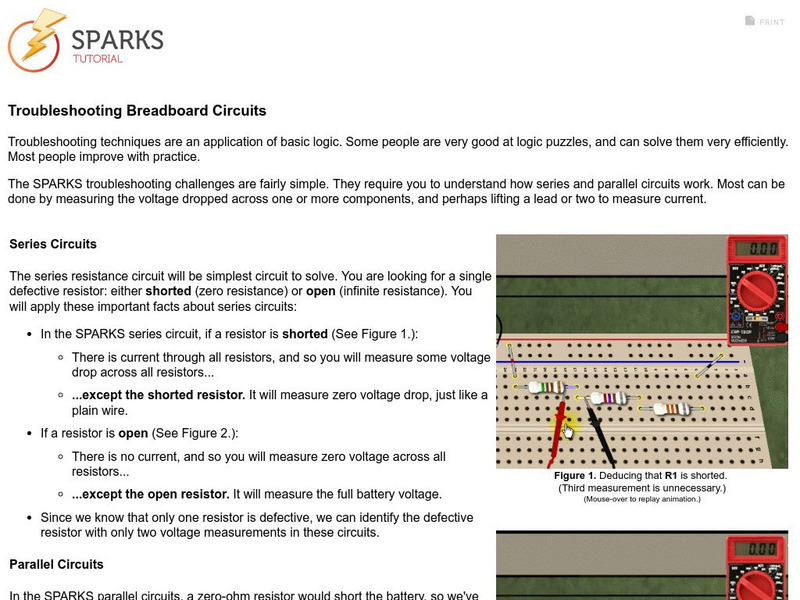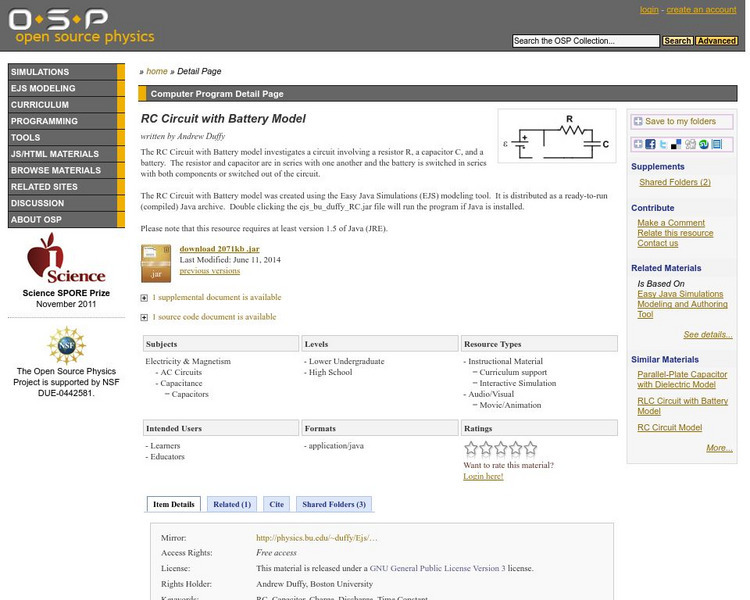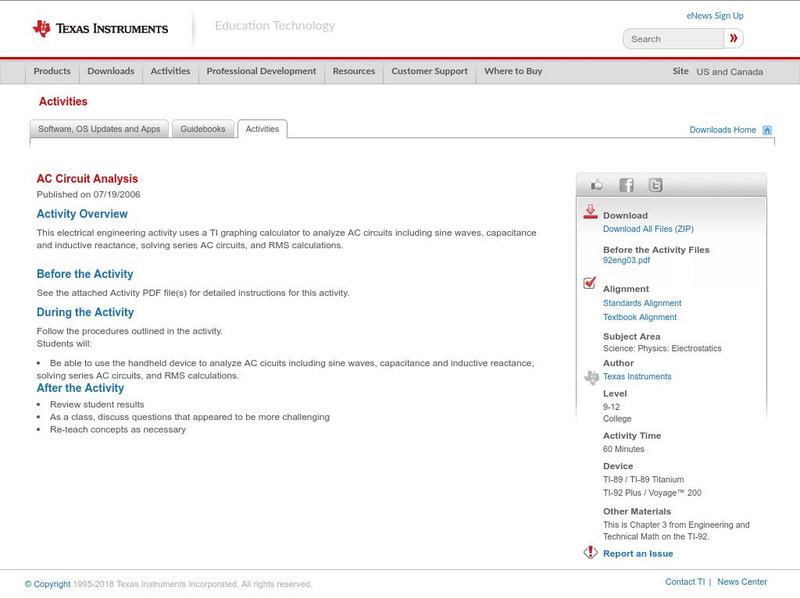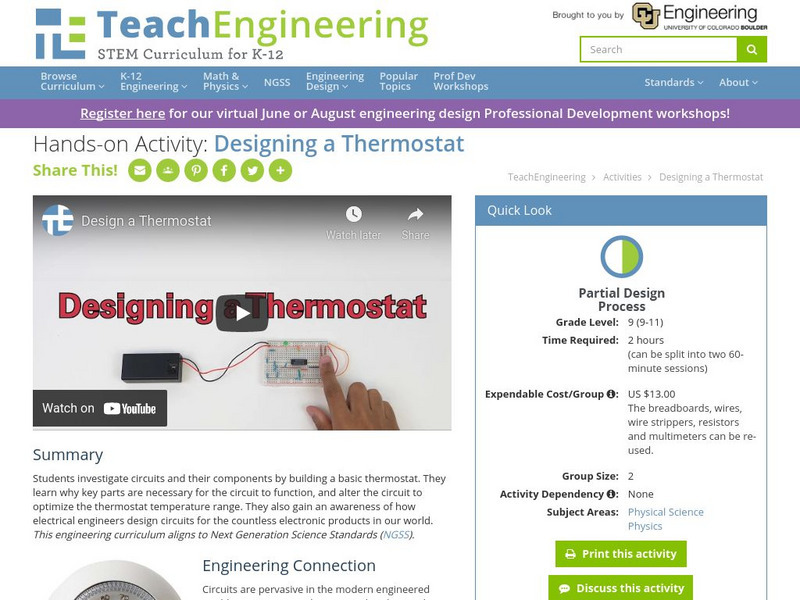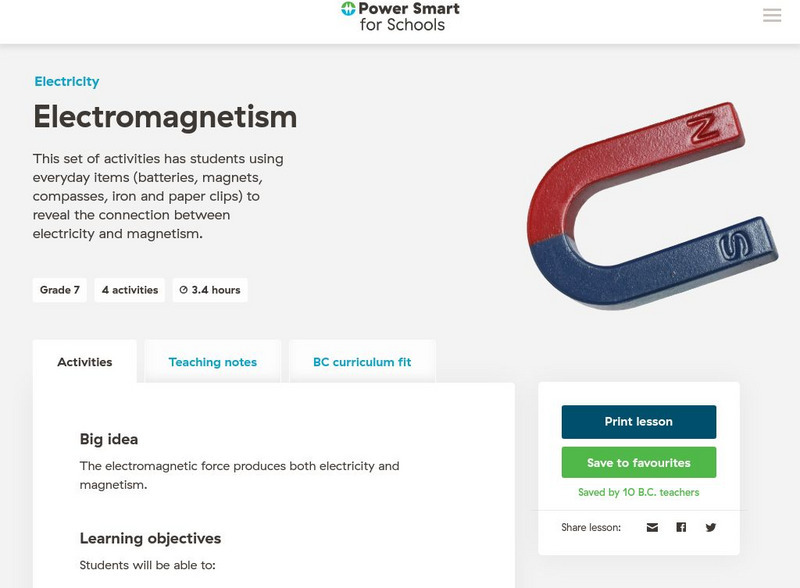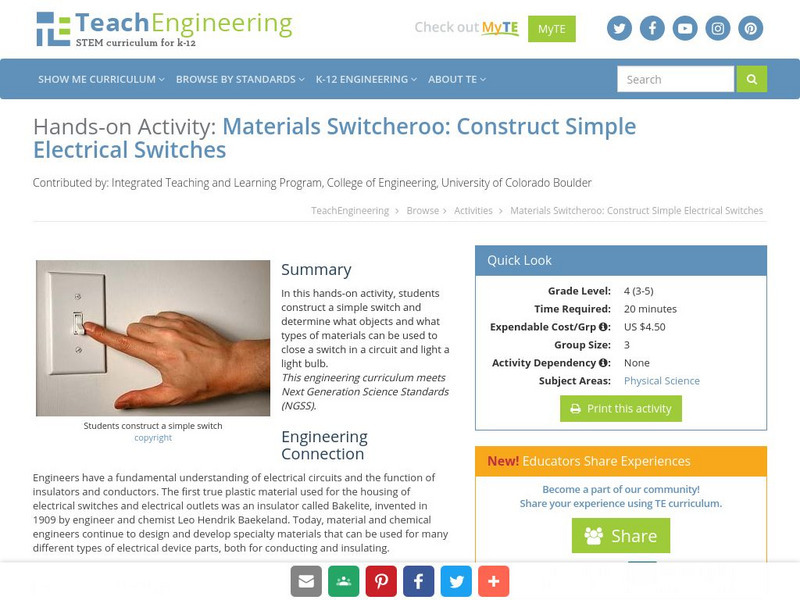Science Education Resource Center at Carleton College
Serc: Investigate Electric Circuits Through Construction and Illustration
In this physics activity 4th grade students investigate electrical circuits in greater depth than the FOSS unit used in a prior grade in school. Students become familiar with a computer simulation allowing them greater choices of...
Science Education Resource Center at Carleton College
Serc: Introduction to Electricity by Creating a Light Up Quiz Board
In this activity, students will learn how to create a simple circuit. They will create a matching quiz board that will light up when the correct pair is selected using electricity vocabulary from the text.
Physics Aviary
Physics Aviary: Simple Circuit Lab
This lab is designed to have students investigate the relationships between voltage, resistance and current in a circuit with only one passive component. The batteries in this simulation can be varied from ideal batteries to batteries...
Concord Consortium
Concord Consortium: Troubleshooting Breadboard Circuits
Try these SPARKS troubleshooting breadboard circuit challenges.
Khan Academy
Khan Academy: Basic Electrical Quantities: Current, Voltage, Power
Build an intuitive understanding of current and voltage, and power.
Other
Easyphysics: Chapter 14 Basic Circuit
Learners investigate circuits. Some topics examined are a series circuit, parallel circuit, and Joule?s law. The resource includes practice problems with solutions and a chapter quiz.
American Association of Physics Teachers
Com Padre Digital Library: Open Source Physics: Rc Circuit With Battery Model
Simulation showing the simplest RC circuit, with a resistor and capacitor in series with one another, and a battery that can be switched in the series, or switched out of the circuit.
Texas Instruments
Texas Instruments: Ac Circuit Analysis
This electrical engineering activity uses a TI graphing calculator to analyze AC circuits including sine waves, capacitance and inductive reactance, solving series AC circuits, and RMS calculations.
American Association of Physics Teachers
Com Padre Digital Library: Open Source Physics: Rlc Circuit Function Generator
An electrical circuit simulation modeling a resistor, capacitor, and inductor in a series. Vary the resistance, capacitance, inductance and source frequency in the simulation.
CK-12 Foundation
Ck 12: Electric Current
[Free Registration/Login may be required to access all resource tools.] The definition of electric current is explained and how to calculate an electric current. Includes links to resources for learning more about electricity, i.e., a...
Science Education Resource Center at Carleton College
Serc: Investigating Testing for Electrical Conductivity Using Materials
In this activity, learners will understand that electricity moves through different circuits and discover what types of materials are conductors and insulators.
Science and Mathematics Initiative for Learning Enhancement (SMILE)
Smile: Electric Currents and Circuits
This cooperative learning activity for intermediate to junior high students has them create various electrical circuits in order to understand electricity.
Other
Articles About "Electricity": New Explanations, Alternate Mental Toolkit
This highly informative site contains many resources and articles on electricity. A wealth of information about electricity can be found. This site also contains many FAQ's.
Ducksters
Ducksters: Kids Science Projects and Experiments: Electric Circuit
Kids learn by experimenting with science. Project on building an electronic circuit.
Ducksters
Ducksters: Physics for Kids: Electronic Circuits
Kids learn about electronic circuits in the science of electricity and physics including schematics, power, ground, components, and the printed circuit board.
ClassFlow
Class Flow: Circuit Conductors
[Free Registration/Login Required] This unit builds on children's previous practical experience of making circuits and extends their understanding of circuits, conductors and insulators and the need for a complete circuit in order for a...
Concord Consortium
Concord Consortium: Calculating Voltage in Series Circuits
See how Ohm's Law can tell us that the voltage across resistors will depend on that current value I and each R-value.
Concord Consortium
Concord Consortium: Calculating Current in Series Parallel Circuits
Use resistance formulas to determine the total resistances of the series and parallel parts. Then, use Ohm's Law to calculate the voltage drops across and currents through each part.
Concord Consortium
Concord Consortium: Calculating Voltage in Series Parallel Circuits
Use the series and parallel resistance formulas to determine the total resistances of the parts. Then, use Ohm's Law to calculate the voltage drops across each part.
TeachEngineering
Teach Engineering: Designing a Thermostat
Students investigate circuits and their components by building a basic thermostat. They learn why key parts are necessary for the circuit to function, and alter the circuit to optimize the thermostat temperature range. They also gain an...
BioEd Online
Bio Ed Online: Neural Network Signals
Nervous system messages are sent as electrical signals along the length of axons and dissolved salts are important for electrical signaling in cells. In this lesson young scholars are introduced to this concept by creating an electrical...
Other
Bc Hydro: Power Smart for Schools: Electromagnetism
This set of activities has students using everyday items (batteries, magnets, compasses, iron and paper clips) to reveal the connection between electricity and magnetism. Ideally, students will already have experience building simple...
TeachEngineering
Teach Engineering: Bulbs & Batteries Side by Side
We are surrounded everyday by circuits that utilize "in parallel" and "in series" circuitry. Complicated circuits designed by engineers are made of many simpler parallel and series circuits. In this hands-on activity, students build...
TeachEngineering
Teach Engineering: Switcheroo
In this hands-on activity, students construct a simple switch and determine what objects and what types of materials can be used to close a switch in a circuit and light a light bulb.
Other popular searches
- Electricity Circuits
- Basic Electricity Circuits
- Electricity Circuits Current
- Electricity Circuits Safety
- Electricity and Circuits
- Basic Electricity and Circuits
- Electricity Simple Circuits
- Electricity Circuits Project
- Electricity Circuits Proiect



